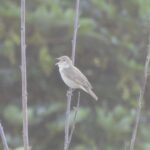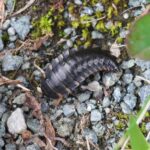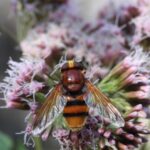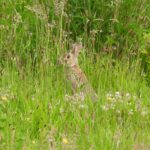A bit about you…
I’m a mum of three grown up children and work part-time in accounts reconciliation in Manchester. I live in Chester but grew up over the border in North Wales. My earliest interactions with nature include collecting stripey caterpillars in jars of ragwort down on the old railway with my brother, which later hatched into stunning cinnabar moths; and enticing unsuspecting spiders onto their webs to capture and identify them.
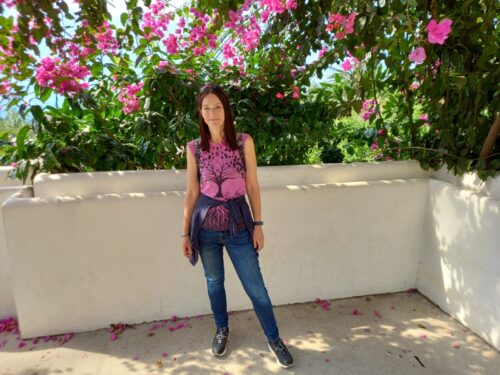
As a teenager I ditched my local government traineeship to go and work on a farm, and indulged in dreams of living a more natural lifestyle and becoming self-sufficient one day. That didn’t happen, but I’ve always maintained a keen interest in environmental issues and felt a growing unease over the years about humans’ impact on the natural world. I feel we need governments to make the big changes, but doing our own bit and joining up our individual actions can make a difference too.
How are you involved in supporting wildlife in your community?
I saw a volunteering opportunity with Sustrans, who were looking for people to help create habitats and record wildlife and, as I’d already begun occasionally planting native wildflower seeds along the Greenway on my way to work and often took photos of birds and insects, I decided to sign up. As Sustrans was one of the partners in the Nature Recovery Corridor Project, the volunteer co-ordinator mentioned the Wildlife Champions course, which I attended, and really enjoyed.
With Sustrans and other groups I’ve been helping with seed and bulb planting, hedge planting, creating wildflower meadows, making bat and bird boxes and bug hotels, maintaining wildlife areas on the Greenway and recording wildlife in different parts of Chester and Cheshire. I’ve been wildlife recording with RECORD (the Local Environmental Records Centre) and to species ID classes online and at the zoo, tried my hand at apple pressing and have also taken part in the zoo’s Hedgehog Watch.
Through Sustrans, the course and various Wildlife Champions events I’ve met lots of like-minded people and made some good friends. I’ve met with a variety of community groups doing brilliant things and learned a lot from them.
Why do you get involved in making wildlife observations?
I discovered iNaturalist a couple of years ago when I heard that a PhD student was surveying an area at the Countess Country Park which would become the Wetland Centre – he wanted people to upload any observations they had made while walking there, to use in his study. It’s easy to use and a great way to log your recordings. I’m lucky in that I have a bridge camera which can zoom in on distant subjects like birds, but I also take a lot of photos with my phone, particularly in macro mode.
Quite often the most interesting subjects present themselves when you’re not equipped with a camera, but a half decent photo with a phone can be good enough to put on iNat to be identified, or birdsong recorded with an app like Birdnet can also be uploaded. Since using iNat I’ve come to further appreciate the wealth and diversity of species which live alongside us; putting names to them and having IDs confirmed by others with more specialist knowledge is satisfying and reading up about them is fascinating.
Best of all is recording the wildlife in the areas your groups have been working to improve for nature, especially if you find something new (to you), or that has not been recorded in the area many times. Seeing a butterfly, bee or other insect on a flower you’ve planted from seed is very rewarding in itself.
Tell us about the impact of these observations?
I’m not an expert photographer or naturalist but I like the kind of interface of art and science that wildlife photography occupies. Nature is like a massive open party to which everyone’s invited and all the different species are interconnected in the web of life and have their own special place within it…but it seems that humans are forever destroying, exploiting or undervaluing it.
I feel that when I capture something in a photo it is in some small way saved and celebrated, and given a tiny bit more significance in the great scheme of things.
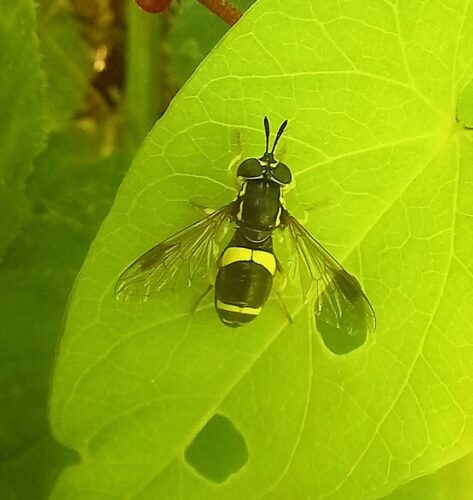
Zooming in can illuminate overlooked details like the intricate plumage of a bird or the strange alien beauty of insects. I think this experience of focusing makes us care more about other species and their precarious lives. And more practically, through iNaturalist, citizen science projects the world over can potentially access this information, to monitor the success or decline of different species, the spread of invasive species, and movement/change of habitat or behaviour due to climate change, for example.
As soon as an observation reaches ‘Research Grade’ on iNat (i.e, someone agrees with your ID on it) it is automatically uploaded to iRecord, part of the National Biodiversity Network, and the Local Environmental Records Centre can access it. For local groups working to increase biodiversity in their areas, recording over time can give an indication of which new plants have successfully established and if these have attracted new or different insects or birds or other wildlife to the area. Anything rare or surprising that turns up can be picked up by experts in the field. Some of the Wildlife Champions have undertaken in-depth surveys with photos of all the plants in their projects.
What is your biggest success and why?
I was pleased to discover some species last year I had not identified previously on the Greenway or in the Country Park, including the hornet mimic hoverfly, lesser hornet hoverfly (several of both species), two-banded wasp hoverfly, silpha tristis beetle and bishops mitre shield bug on the Greenway, and an emerald damselfly at Northgate Ponds. I saw an Essex skipper and a garden warbler at the Country Park. The garden warbler sounds dull but is quite elusive and similar in appearance to other warblers, so was identified from sound recordings as well as photos. Some interesting birds along the local Greenway were nesting goldcrests and sparrowhawks, and ravens spotted on several occasions.
Overall there seemed to be an increase in the number and diversity of hoverflies on the local Greenway and more bees than I had recorded previously in the area, which felt like a positive trend, even if only based on my own observations!
I also went out recording with Record LRC when they wanted volunteers and loved that – being with people who do this as a regular thing, are really knowledgeable and actually extract scientific data from their findings. Last year Record also organised Chester’s entry in the City Nature Challenge, an international Bioblitz, where participants across the world record as many species as possible over a 4 day period and Wildlife Champions were invited to get involved.
What would you say to others who are thinking of taking action for wildlife?
Wildlife Champions are, in my experience, a group of genuinely caring people with a wealth of positive energy and diverse ideas and talents.
At a time when it can seem that nearly all environmental news is bad news I think that volunteering for nature and meeting regularly with other like-minded people is a very positive thing to do. I’m pleased that the Networks for Nature project has expanded this year to other areas, and would urge anyone with a love of nature or a few hours to spare to get involved, whether that’s recording or more practical tasks – whatever you have to offer.
I was inspired by the Wildlife Champions course to ‘rewild’ my own garden to a great extent. I learned that while planting pretty wildflowers for pollinators is great, sometimes it’s the ‘weeds’ growing naturally which the local wildlife really need to breed and feed on. We’ve put in lots of native species more recently, but it’s been a challenge to persuade my husband that allowing selfheal, birdsfoot trefoil and ragwort to take over our lawn is a very good idea!
I would like my small suburban garden to be an open house for any creature or plant that wants to be there (within reason!) as native habitat becomes squeezed into ever smaller pockets of land. Hedgehogs and a fox show up regularly on my wildlife camera and we have occasionally seen a badger, rabbit and ducks; we have a pond full of newts and are visited by a diverse range of birds and insects. I am tempted to allow it to turn into a jungle!
However, other Wildlife Champions and their projects remind me how necessary our interventions can be; that cutting back strengthens new growth, or lets in light, or gives different plants their opportunity to grow. That mowing can replicate the browsing of animals in the wild. And also, lovely gardens make people happy. Supporting nature is a kaleidoscope of actions and approaches, and Wildlife Champions are, in my experience, a group of genuinely caring people with a wealth of positive energy and diverse ideas and talents.
NOW is the time to ACT FOR WILDLIFE. Conservation is CRITICAL; species are under threat. TOGETHER we can make a BIG difference. Take action TODAY and join us in PREVENTING EXTINCTION.
